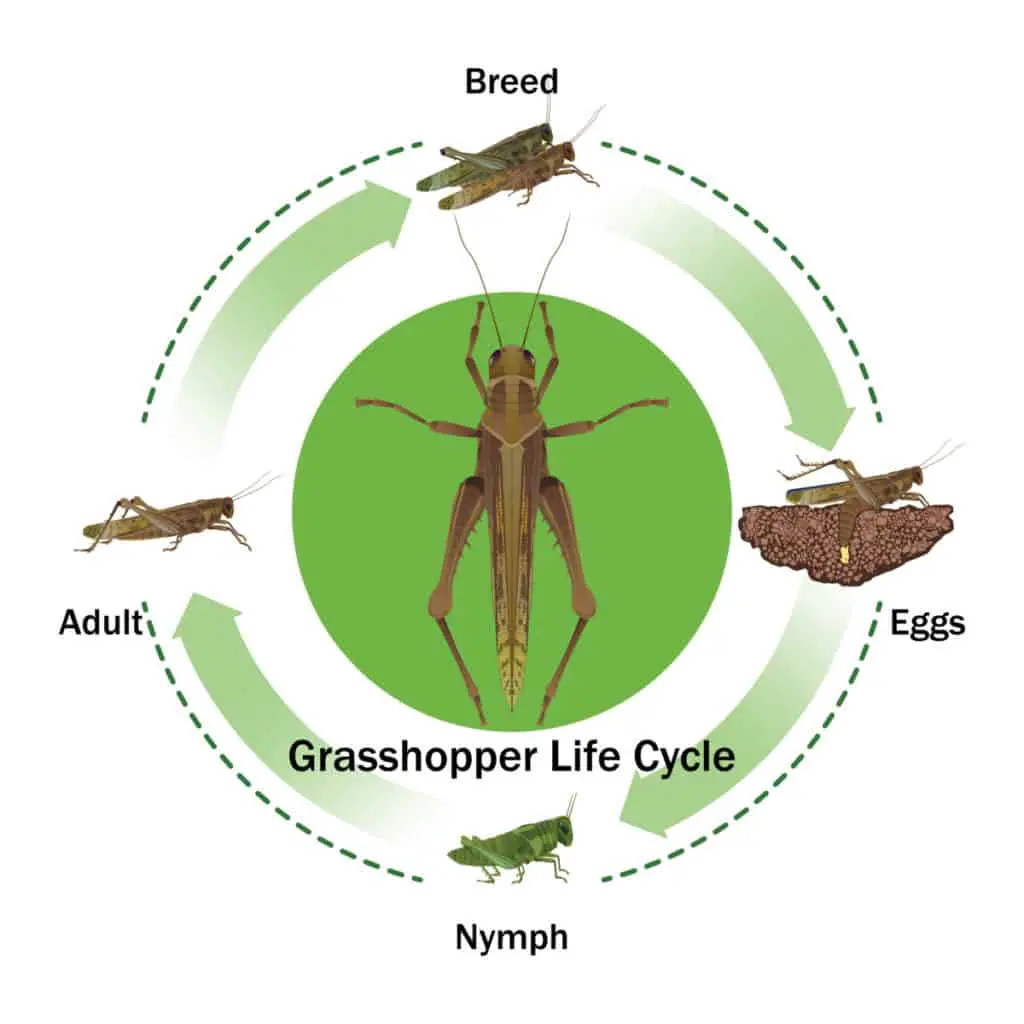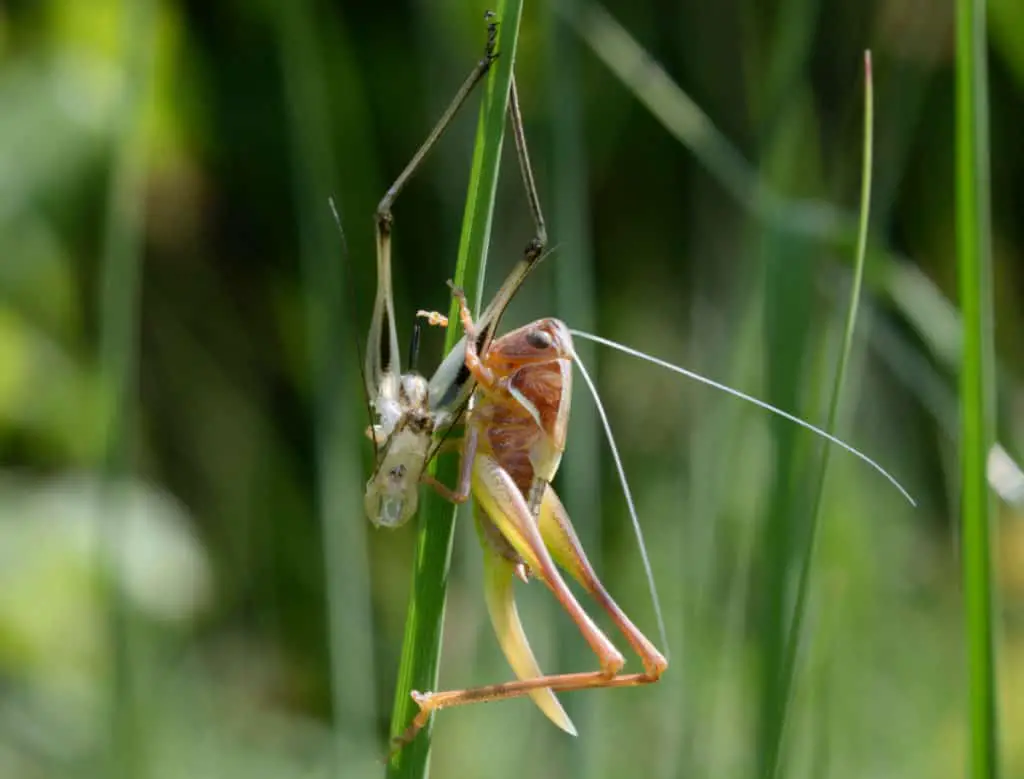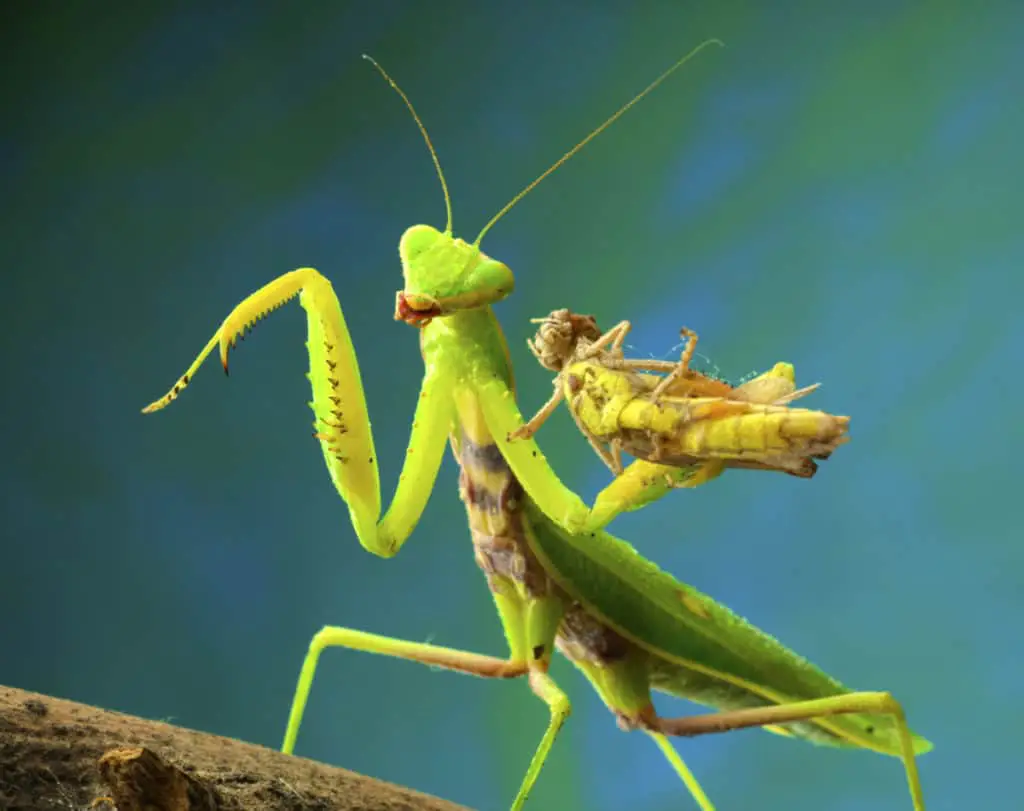Have you ever seen what looks like the skin of a small grasshopper but are not sure where it came from?
While many will not give it a second thought, this tiny grasshopper shell is in fact the outermost layer of a young grasshopper.
Do grasshoppers molt? Yes, grasshoppers molt five or six times transforming from the small nymph that emerges from the egg to an adult grasshopper. The body mass of the grasshopper doubles between each molt. The five to six molts take up to 60 days.
Through a series of molting processes, the young grasshopper will eventually turn into the giant grasshopper seen munching away greedily at your vegetation in the garden.
Stay with us as we take a detailed look at how and why grasshoppers molt. Also, the risks for the grasshopper when they molt and how this influences their survival rate from nymph to adult grasshopper.
What Is Molting?
Molting is a natural process involving the shedding or getting rid of the outside layer/covering of an insect, snake, or even though less thought of, the shedding of human skin.
The molting process not only involves the removal of outer layers but, according to Britannica, also involves the formation of the replacement of this layer.
The molting process can include the shedding or replacement of skin, hair, feathers, and even horns.
This process is regulated primarily through hormones.
Molting takes place in much of the animal kingdom and can be witnessed in birds, nematodes, tardigrades, and arthropods, which of course include grasshoppers.
Why Do Grasshoppers Molt?
Grasshoppers are covered in an external skeleton called an exoskeleton. Think of this as a suit of armor that a knight would wear.
Just like a knight’s armor, this exoskeleton is a hard protective layer, but is not flexible and therefore cannot grow with the existing body of the grasshopper.
As the grasshopper grows, it sheds the old exoskeleton and a new soft one is grown in its place.
This will harden with time but can leave the grasshopper vulnerable during this stage.
The process of molting needs to take place multiple times before the nymph reaches adulthood where it will be ready to mate, lay eggs, and then repeat the process.
How Many Times Do Grasshoppers Molt?
The grasshopper’s life cycle consists of three stages – the egg, nymph, and adult. This change from different states is also called incomplete metamorphosis.

The little creature hatching from the egg is called a nymph.
Nymphs are similar to adults, with a much lighter pigment and of course much smaller. As nymphs grow, they shed their exoskeletons five to six times before they finally reach adulthood and become a fully-grown grasshoppers.
Do Grasshopper Molt Through Different Life Stages?
Because grasshoppers go through an incomplete metamorphosis, it is expected that their molting patterns will differ from stage to stage.
Molting During The Egg Stage
During the egg stage of its life cycle, there is no metamorphosis as the nymph is still soft and forming the shape that it will emerge from the egg in.
If you would like to know more about the egg stage of the grasshopper’s lifecycle then check out this article we have written specifically on that topic, Do Grasshoppers Lay Eggs?
That leaves the adult and nymph stages to be discussed.
Molting During The Nymph Stage
The start of life for the young nymph involves breaking free from the egg. Although they are soft at this stage they find themselves inside a “honeycombed” egg pod, buried underground.
Their soft bodies are protected by a hatching skin, which sheds as soon as they emerge from the ground.
The grasshopper nymph looks like the adult, but is a much smaller version, with a few missing features – in this case, the absence of functional wings, reproductive organs, and fewer antennal segments.
Every time a nymph molts, it will increase in size and the wings will grow closer to their final formation.
Nymphs feed on soft plant foliage directly after hatching and after up to 60 days, which include five to six moltings, the nymph can reach adulthood.
The body mass of the nymph doubles between every molt. This forces them to shed their exoskeleton to fit their new body into a new, more suitable shell.

Although grasshoppers grow their own “shell” this can be looked at in the same way as a hermit crab operates. When the crab is too big it leaves its shell for a larger home.
The grasshopper nymph is called an instar between the different molts, so once it hatches from the egg and sheds the serosal skin, the hatchling is the first instar.
Molting During The Adult Stage
Adult grasshoppers do not molt. Once the grasshopper reaches adulthood, they have one goal, and that is to mate and continue the life cycle.
After their final molt, the now-adult female grasshoppers generally do not lay eggs until they are one to two weeks old, allowing them to gain enough weight before laying their first batch of eggs.
Egg-laying will take place for a few days over a period of two weeks, depending on the species.
After this, the female grasshopper will die. Adult grasshoppers generally live for around nine to eleven weeks.
How Do Grasshoppers Molt?
The tough exoskeleton of the grasshopper consists of chitin, a fibrous substance consisting of polysaccharides, which is the major constituent in the exoskeleton of arthropods and the cell walls of fungi (think of this as the steel that is used to make armor).
Unfortunately, this exoskeleton can’t grow, but the insect still grows on the inside. When the time is right, the grasshopper will shed this outside layer in exchange for a much bigger one, and the process is repeated.
The actual body is made up of numerous segments of hard tissue separated and connected by flexible membranes. These stretch and allow for limited growth before it needs to molt again.
How Long Is It From Nymph To Adult For Grasshoppers?
As previously mentioned the nymphs will molt five to six times before reaching adulthood, again depending on the conditions.
Nymphs can repeat the entire process from hatching to adulthood in anything from one to two months.
The time between emerging from the egg and adulthood depends on the different species and the conditions.
If there is a shortage of food, the process may take longer.
The life cycle of the grasshopper from the moment they hatch to adulthood where they mate, lay eggs, and die, is about a year.
However, the process can be halted at any time if conditions are not favorable, so this may influence the amount of time in a cycle.
If food is plentiful, the young grasshopper will move through the various stages of its life much quicker.
You may already know that grasshoppers are prolific eaters but have you ever wondered if they have the ability to bite people and if they can it is harmful to us? We have the answers in another article we have written called, Do Grasshoppers Bite?
The Risks And Downsides Of Molting For Grasshoppers
There are numerous risks associated with insect molting. This not only involves not eating during this time frame, but many of the insects also lie still during the process.
As a result of their lack of locomotion, they become vulnerable to predators that might be looking for a quick meal.
Arthropods shed more than just their outer body covering.
Their eye surfaces, the lining of their fore and hindgut, and the lining of the internal passageways leading to the respiratory system are also shed in the molting process.
This can result in death if an eyeball or leg gets broken off, or in the case of the grasshopper getting stuck in the skeleton. An injured grasshopper although able to sense a predator without the ability to jump effectively even ants become a real threat to them.
Immediately after molting, the exoskeleton is still soft, so this leaves the arthropod unable to defend itself.
Research has also found that grasshoppers lost jumping endurance between molts, which could be an indicator that they might have issues with oxygen delivery during this period.
Their ability to jump is one of a grasshopper’s best defensive tactics. Without this, they are at a huge disadvantage.
Less than 20% of nymphs will make it to adulthood, and the molting process that they go through is a major contributor to this low survival rate.
According to Sciencemag.org, a study done on mayfly larvae revealed that these critters can’t breathe during the actual molting process.
While the study was done on mayflies specifically and not grasshoppers, it shows just how vulnerable an insect can be during the molting process.
Want to know more about the relationship between grasshoppers and praying mantis? Then check out the detailed comparison we have done between the two, Grasshopper Vs Praying Mantis
The Wrap Up
Grasshoppers’ last line of defense in order to survive an attack from a predator is their hard armored shell known as the exoskeleton.
Although this is an important part of the species survival, it does not grow with the body of the insect, and therefore needs to be shed. This process is known as molting and occurs five to six times during the nymph stage of a grasshopper’s life cycle.
Molting leaves a grasshopper susceptible to predators but is a necessary part of the insect reaching adulthood where it can continue the cycle of the species.
So next you see what looks like the skin of a grasshopper in the garden you will know how it got to be there.
Sources
https://www.britannica.com/science/molt
https://askabiologist.asu.edu/incomplete-metamorphosis
https://www.backyardnature.net/grasshop.htm
https://www.wamc.org/post/dr-scott-kirkton-union-college-understanding-molting-process-grasshoppers
http://www.uwyo.edu/entomology/grasshoppers/field-guide/ghcycle.html
http://bioweb.uwlax.edu/bio203/s2012/schiappa_char/reproduction.htm
https://www.wamc.org/post/dr-scott-kirkton-union-college-understanding-molting-process-grasshoppers

